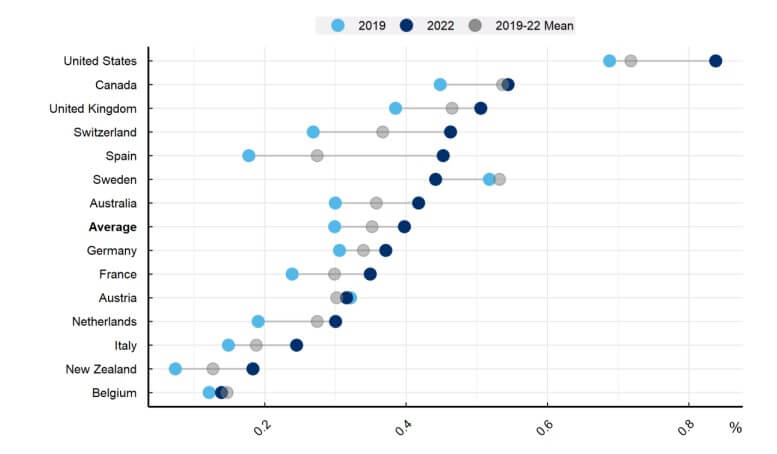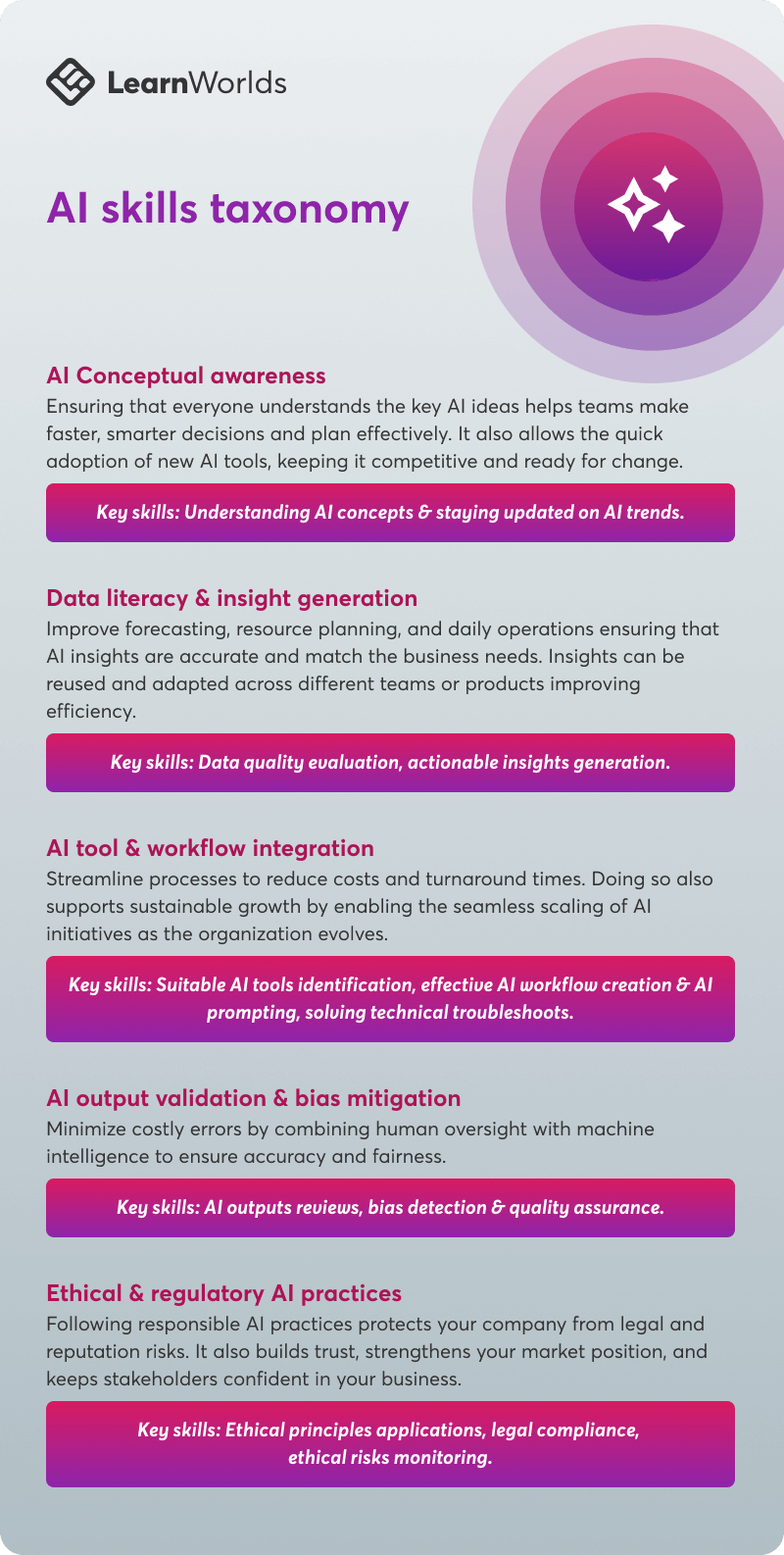Table of Contents
When IKEA introduced AI chatbots to resolve nearly half of its customer support tickets, it faced a huge challenge: ensuring its employees remained relevant and empowered. Instead of displacing its workforce, IKEA chose to reskill 8,500 employees in remote interior design—a bold move that maintained employee engagement and created new opportunities to serve customers.
For many businesses, the adoption of Artificial Intelligence (AI) presents similar pain points. The growing AI skills gap leaves teams struggling to keep up with new tools and technologies. Employees may feel uncertain or even resistant to AI, fearing its impact on their roles. At the same time, delivering consistent and scalable AI training for employees across departments, locations, or hybrid teams often feels out of reach.
AI-based employee learning programs offer a clear solution. When companies invest in targeted training programs, they can help close the skills gap, make employees more open to change, and build their confidence. Teams that are properly trained can use AI to make better decisions, work more efficiently, and come up with new ideas. For example, IKEA used AI tools to help retrain their employees, showing how AI can be put to good use in helping people grow in their roles.
This article provides actionable insights for HR leaders, training managers, and executives on how to build effective AI-driven workforce development strategies. With platforms like LearnWorlds, you can create scalable, personalized programs that empower employees to embrace AI, ensuring your workforce stays ahead in a competitive, tech-driven world.
Key takeaways
Here’s what you will learn in a nutshell:
AI training bridges the skills gap, equipping employees—especially frontline workers—with tools to adapt and thrive in AI-driven industries like retail and healthcare.
What is AI and why should your employees be trained?
Generative AI is transforming business as we know it. Defined as a branch of artificial intelligence capable of creating new content—whether text, images, code, or even music—based on the data it has learned, generative AI is reshaping industries.
Powered by machine learning, it automates repetitive tasks, drives innovation, and provides employees with tools to work smarter and faster. Experts agree that generative AI tools bring big changes to how work gets done and how decisions are made. That’s why teaching employees how to use AI is so important for staying competitive.
Why train employees in AI? As companies start using AI more, it brings both challenges and opportunities. Without the proper training:
However, using artificial intelligence for training purposes solves these pain points. A recent OECD study found that 80% of employees using AI reported improved performance, and workers were four times more likely to say that AI enhanced their job satisfaction and working conditions than worsened them. Proper training enables employees to focus on creative, high-value tasks while AI handles repetitive workflows.
The competitive advantage of training
Another study examining AI adoption by small to medium-sized businesses revealed that organizations that prioritize AI training solutions get to see measurable benefits:
When small businesses use AI, they can save the same amount of work as what two full-time employees would handle. These savings can be used to pay higher wages, pay off debt, or help the business grow.
The bottom line? Training employees to use AI helps them feel more confident, work more efficiently, and come up with new ideas. Businesses that invest in tools to build AI-related skills are preparing themselves for the future and staying ahead of the competition.
The growing AI skills gap: Who is embracing AI?
The rapid adoption of generative AI has exposed a critical skills gap across industries, threatening business productivity and equity. A recent study by the OECD found that the demand for AI skills in job listings grew by 33% worldwide. In some countries, like Spain and New Zealand, it jumped by more than 150% between 2019 and 2022.
Even with this rise, a survey from Deloitte showed that only 17% of companies are making significant investments in training their employees to use AI. This means many workers aren’t fully prepared to make the most of these tools. This gap is especially worrying in healthcare, retail, and tech industries, where AI is used a lot but still depends on skilled workers to unlock its full potential.

💡For instance, studies show that 95% of executives believe AI projects won’t succeed without properly trained employees. However, there are still gaps when it comes to who gets trained. Baby boomers are half as likely as Gen Z to receive AI training, and 42% fewer women say they feel confident using AI compared to men.
To close these gaps, companies need to focus on training strategies that include everyone. By giving employees the skills they need to use AI well, businesses can grow sustainably and stay competitive in a world where AI is becoming more important.
How AI impacts frontline workers and why employers should prioritize training
Is your frontline team ready to succeed in a world where AI is changing how we work? While AI is often linked to tech teams, it’s also transforming frontline jobs.
For example, retail workers use AI tools to suggest personalized products to customers, and healthcare staff rely on technology to provide faster, more accurate care. These tools help make daily tasks easier, letting employees focus on work that needs human creativity and judgment.
But without proper training, frontline workers can feel overwhelmed by these tools. This can lead to frustration and even higher turnover rates. Training helps by building confidence and teaching employees how to use AI effectively.
💡In fact, an OECD study found that 80% of employees who received AI training reported better performance and improved work conditions, showing just how valuable preparation is.
Employers who focus on training their frontline teams see more than just better efficiency—they gain a real competitive advantage. Skilled workers do their jobs better, feel more engaged, and build stronger connections with customers, which boosts the company’s reputation.
AI’s Role in retail, healthcare, and other industries
The impact of AI on frontline workers goes beyond individual roles as by experience we see that it is transforming entire industries. While AI promises incredible advancements, many businesses face the challenge of ensuring their workforce can effectively use any AI tools.
AI’s potential remains underutilized without proper training, and employees feel overwhelmed or disengaged. Here’s how AI is reshaping key industries—and why training your team is critical to overcoming these pain points.
No matter the industry, a common issue is that employees often feel unprepared to use AI tools. This can lead to frustration, mistakes, and missed opportunities.
By providing focused training, you can help your team feel more confident and ready to use AI effectively, ensuring better results for your business. This investment addresses employee uncertainty and operational inefficiencies, paving the way for improved productivity and innovation—a focus of the next section.
Empowering frontline workers with training on AI tools for increased productivity
What’s the biggest benefit of AI training for frontline workers? According to a Deloitte study, increased productivity remains the top advantage, cited by 42% of organizations.
However, the benefits don’t stop there—58% of respondents noted other critical gains, such as increased innovation, improved customer relationships, and enhanced products and services. AI training, when embedded deeply into business functions, unlocks this full spectrum of opportunities.
IKEA provides a compelling example of what’s possible. By reskilling 8,500 employees to adapt to AI-driven changes, such as chatbots handling customer queries, the company empowered its workforce to focus on higher-value tasks like remote interior design. This effort supported employees during a time of change but at the same time, brought in an impressive $1.4 billion in additional revenue.

Upskilling is more than just a quick fix, it’s a smart investment aiming at the long-term success of a business. According to the World Economic Forum, more than half of the global workforce will need to learn new skills or update existing ones by 2025 to keep up with changing technology.
Organizations that focus on talent development rather than recruitment will not only meet current needs but also position themselves for future success. This global focus on upskilling could boost the annual GDP by $6.5 trillion by 2030, showing that investing in employees benefits both workers and businesses.
Key elements for effective AI employee training programs
To design effective AI tool training, companies should start by figuring out the specific skills employees need to meet both business goals and the requirements of their roles.
A structured taxonomy of AI-related skills ensures training efforts are focused, scalable, and tied to measurable outcomes. Below is an AI skills taxonomy designed to link employee development with broader business objectives:

The above AI skills taxonomy will help you identify the skills gap and as a next step will allow you to turn these gaps into learning objectives and measurable training outcomes.
Once you decide on the expected learning outcomes you can select the training methods of generative AI upskilling/reskilling. Depending on your budget, you can choose from different training options. These include on-site or in-person training, a mix of in-person and online sessions, or fully online training. Online training is easy to scale, track, and make available to all employees, whether they work remotely or on-site.
Now, let’s explore how these competencies can empower employees to take ownership of their AI learning, fostering a culture of self-driven growth and adaptability.
Empower employees to take the lead in their AI learning
How do you help your team feel confident about using AI? The key is to make employees the focus of the learning process. Online training platforms are a great way to spark curiosity and keep employees engaged. These platforms let people explore and build their AI skills at their own pace by:
The impact: With tools that support self-paced learning, employees feel empowered to learn and use AI confidently. This approach boosts innovation, and adaptability, and helps build a team that’s ready to tackle future business challenges.
Focus on building AI literacy across your team
Can your team speak AI fluently? Building AI literacy is essential for equipping employees across all roles—from frontline workers to leadership—with the skills to understand and leverage generative AI tools. Again, online learning platforms play a crucial role in scaling AI literacy across an organization.
Using the AI skills taxonomy, organizations can:
The impact: AI literacy training delivered online fosters collaboration, boosts team confidence, and creates a digitally fluent workforce ready to adapt to the demands of an evolving business landscape.
Develop long-lasting, practical AI skills
What’s the value of AI training without practical application? Developing practical, real-world skills ensures employees aren’t just learning concepts but are applying them effectively in their roles. Online employee training platforms are ideal for embedding these skills into workflows.
The skills taxonomy provides a roadmap to focus on:
The impact: With online training delivering hands-on, practical content, employees become confident users of AI, driving measurable improvements in productivity, decision-making, and innovation. Organizations that prioritize applied skills are well-positioned to lead in a competitive, AI-powered marketplace.
What employers and employees need from AI training
Now that we’ve looked at how AI affects frontline workers, let’s focus on what makes AI training truly effective: meeting the needs of both businesses and employees.
Learning programs help businesses boost productivity and innovation while also supporting employees’ career growth, creating a strong and beneficial balance. This approach helps companies stay competitive and builds a motivated, future-ready workforce.
Employers’ expectations from AI training programs
For businesses, AI training is essential for long-term success. Take, for example, a growing SaaS company introducing predictive analytics tools.
Without proper training, employees might misuse these tools, leading to missed opportunities and wasted resources. But with the right training materials, staff can learn how to use these tools effectively, resulting in faster workflows, better customer service, and higher profits.
Employers expect AI training to:
When AI training aligns with these priorities, it becomes a powerful driver of organizational success.
Employees’ needs for AI skill development
For employees, skills training is about safeguarding their careers and enhancing their value. Imagine Alex, a retail associate, skeptical about AI-driven inventory systems.
Through hands-on, training sessions, Alex not only learns to navigate the system but sees how it streamlines tedious tasks, allowing more time for customer interaction and sales strategy. The result? Alex feels more confident and indispensable.
Employees look for training that:
When employees see the personal value in AI training, they become active participants, ensuring both their success and the company’s.
Final Thoughts
The rapid adoption of AI is reshaping industries, and AI training solutions for businesses are becoming a competitive asset.
Whether it is empowering employees to take the lead in their AI learning or building teamwide AI literacy and developing long-lasting, practical skills, this article has shown how effective training can fuel innovation, productivity, and growth.
Organizations can create a future-ready workforce equipped to navigate the evolving AI landscape by aligning training with business objectives and employee aspirations.
Why choose LearnWorlds for your AI training needs?
LearnWorlds is the ultimate solution for implementing comprehensive, scalable AI training materials. Here’s how it supports your workforce development goals:
By investing in LearnWorlds, you will have the tools to develop a cutting-edge learning program that empowers your workforce, enhances engagement, and supports your business objectives.
AI is here to stay, and organizations that prioritize workforce training will lead the way in this new era. Don’t wait to prepare your employees for the future. With LearnWorlds, you can scale your learning programs effortlessly while delivering impactful, personalized learning experiences.
Ready to future-proof your workforce? Get your 30-day free trial with LearnWorlds today and see how it can revolutionize your AI training courses as part of your employee growth strategy.
FAQs
How can AI help employee training in the workplace?
AI enhances employee training by delivering personalized learning paths, automating administrative tasks, and providing real-time feedback. AI-powered tools, like interactive assessments and adaptive learning platforms, help employees master concepts more efficiently while ensuring training aligns with business objectives.
What is generative AI for employee training?
Generative AI in employee training creates tailored educational content, such as interactive scenarios, quizzes, and learning materials, based on data and learner needs. It enables dynamic, engaging training experiences that improve retention and support individualized learning goals.
Sources
Panagiota is an Instructional Technologies Specialist at LearnWorlds, holding a Ph.D. in Technology Enhanced Learning. Her research focuses on the integration of educational technologies into learning and instruction. In her spare time, she enjoys gardening and staying connected with nature.



